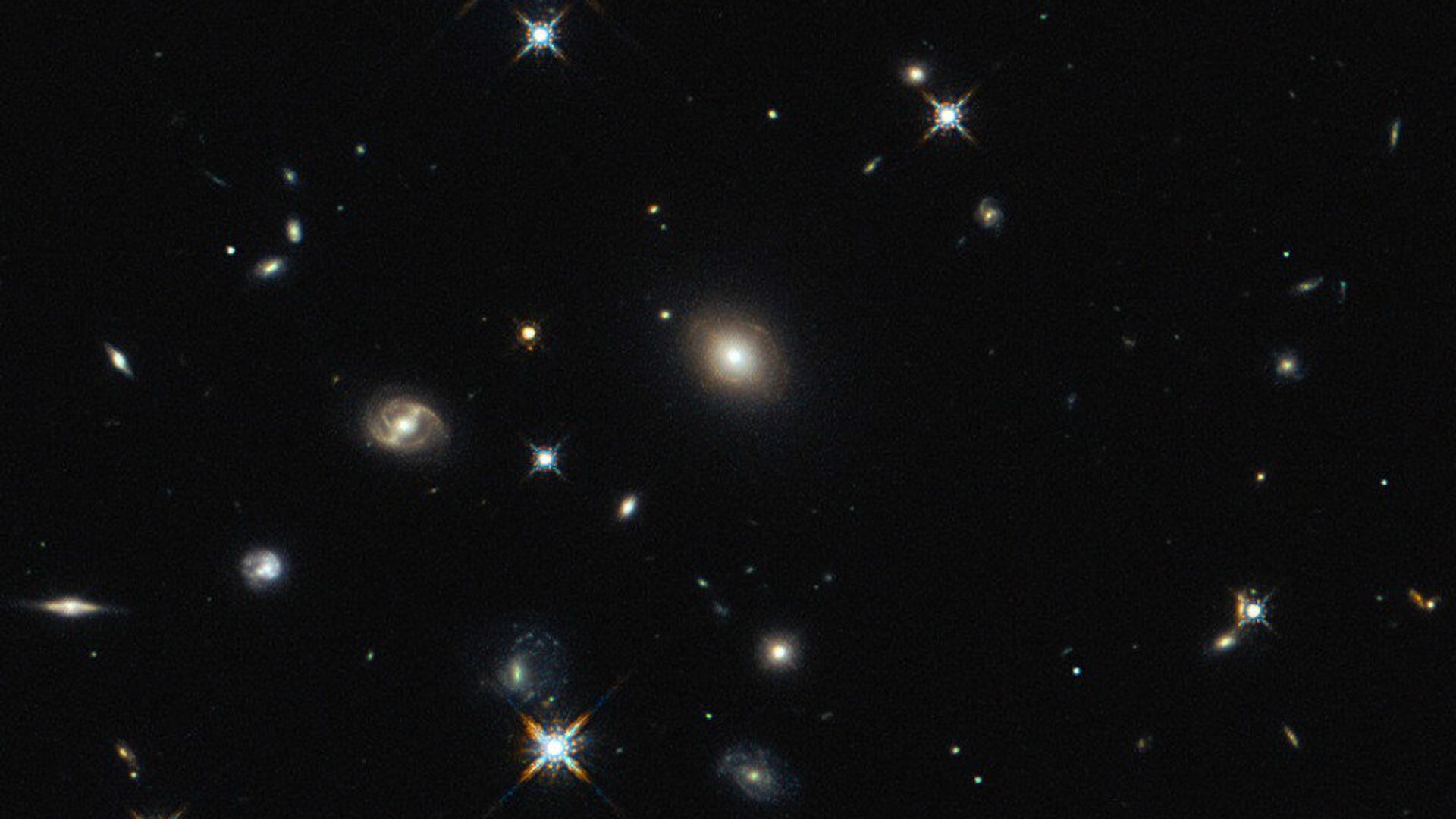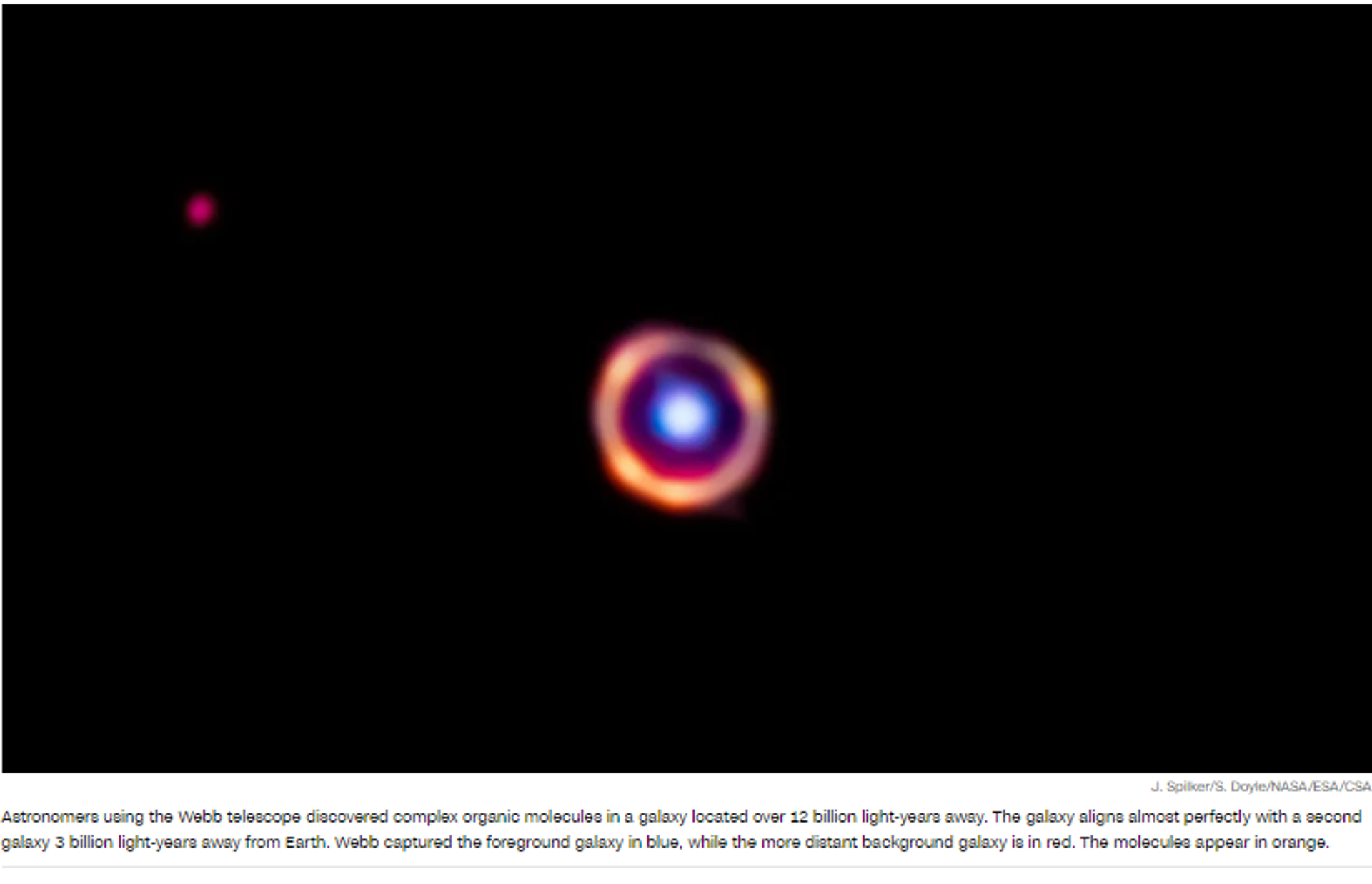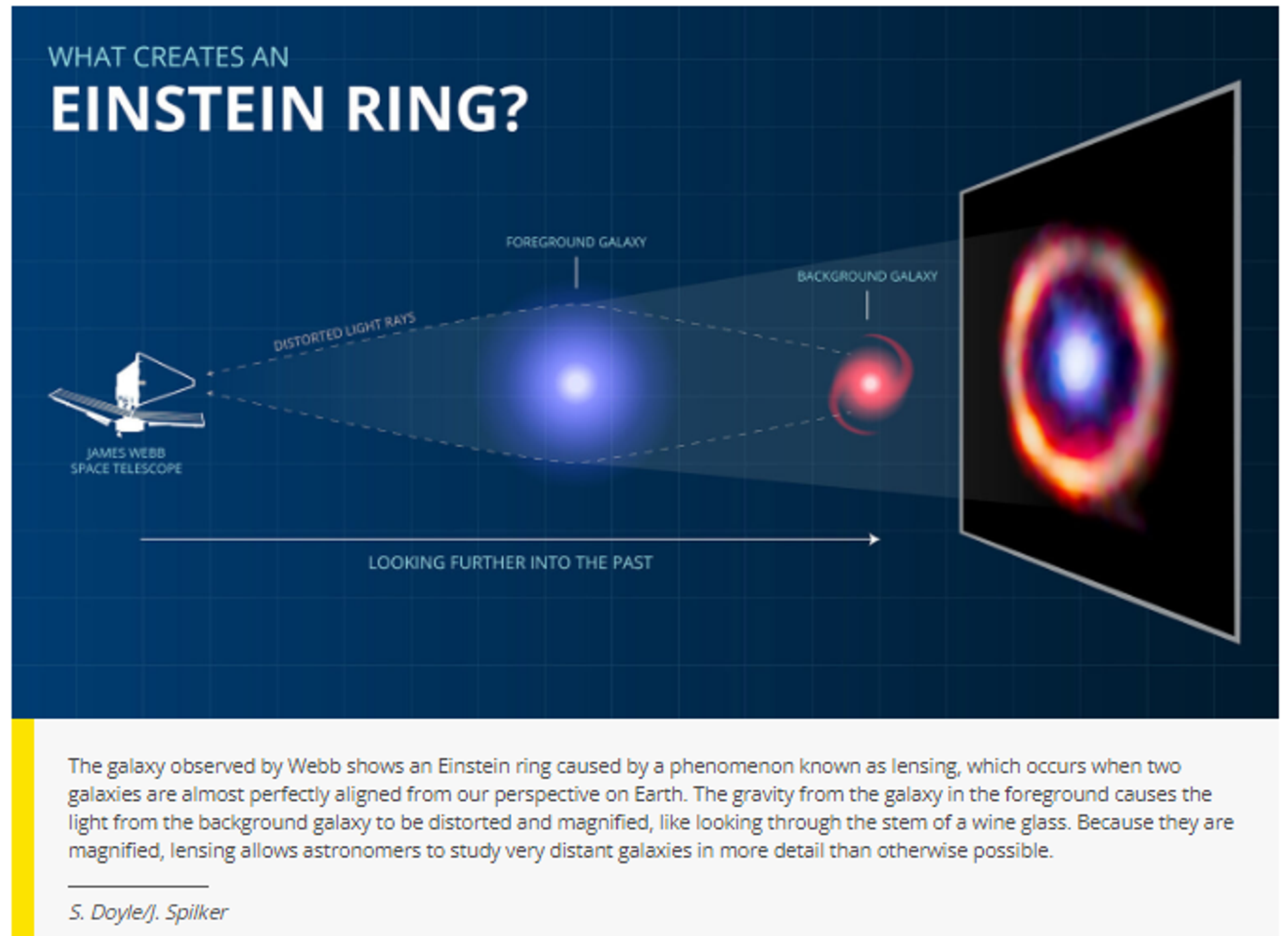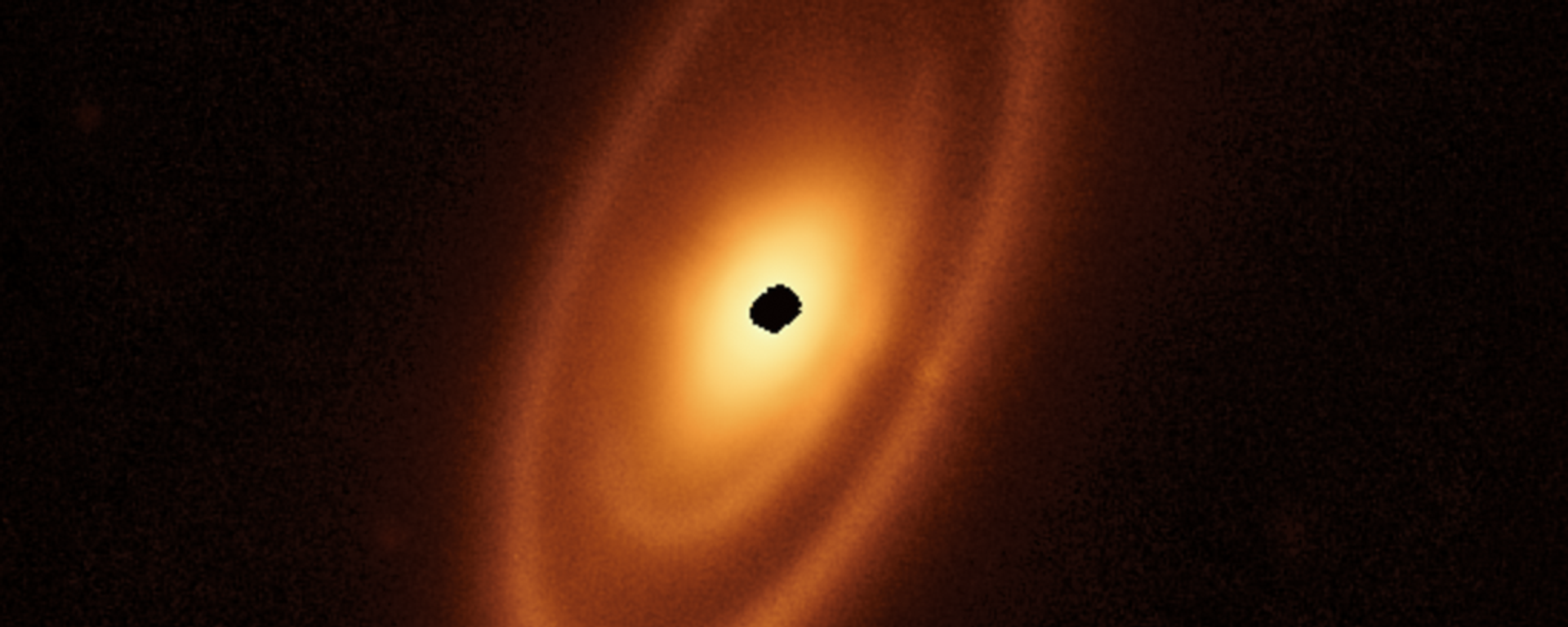https://sputnikglobe.com/20230607/cosmic-magnifying-glass-helps-detect-most-distant-organic-molecules-in-early-universe-1110972641.html
'Cosmic Magnifying Glass' Helps Detect Most Distant Organic Molecules in Early Universe
'Cosmic Magnifying Glass' Helps Detect Most Distant Organic Molecules in Early Universe
Sputnik International
Complex organic molecules have been detected in a distant galaxy more than 12 billion light-years away.
2023-06-07T11:16+0000
2023-06-07T11:16+0000
2023-06-07T11:16+0000
beyond politics
james webb space telescope (jwst)
space
molecules
organic
galaxy
nasa
albert einstein
science & tech
hubble space telescope
https://cdn1.img.sputnikglobe.com/img/102311/60/1023116097_0:125:1001:688_1920x0_80_0_0_5c9a4e6d44af7fa43497cbfe952265c6.jpg
Complex organic molecules have been detected in a distant galaxy more than 12 billion light-years away.Using the infrared capabilities of NASA's James Webb Space Telescope, astronomer Justin Spilker of Texas A&M University, along with a group of collaborators, were studying a distant galaxy - SPT0418-47 - that had been discovered by the National Science Foundation’s South Pole Telescope in 2013. They were able to discern a telltale signature of large organic molecules, akin to smoke or smog on Earth, according to findings laid out in the paper, 'Spatial variations in aromatic hydrocarbon emission in a dust-rich galaxy', published online. These molecules are called polycyclic aromatic hydrocarbons.Another phenomenon - gravitational lensing - helped the astronomers to make their discovery. Gravitational lenses are called natural cosmic telescopes, as they allow scientists to observe galaxies far beyond the reach of powerful space telescopes. This occurs as a result of something that was originally predicted by Albert Einstein in his theory of general relativity.Gravity bends the path of light, and massive astronomical bodies, such as galaxies, can magnify the light from more distant objects.But what makes this discovery a milestone is that it appears to cast doubt on an earlier theory.Another member of the research team, University of Illinois Urbana-Champaign graduate student Kedar Phadke, who spearheaded the technical side of the Webb observations, added that such discoveries is what Webb "was built to do".
https://sputnikglobe.com/20230509/webb-discovers-two-dust-rings-around-young-star-may-provide-clues-of-how-planets-form-1110210105.html
Sputnik International
feedback@sputniknews.com
+74956456601
MIA „Rossiya Segodnya“
2023
News
en_EN
Sputnik International
feedback@sputniknews.com
+74956456601
MIA „Rossiya Segodnya“
Sputnik International
feedback@sputniknews.com
+74956456601
MIA „Rossiya Segodnya“
complex organic molecules, distant galaxy, more than 12 billion light-years away, polycyclic aromatic hydrocarbons, nasa’s james webb space telescope, infrared capabilities, gravitational lensing, natural cosmic telescopes, two galaxies almost perfectly aligned, einstein ring, albert einstein’s theory of general relativity.
complex organic molecules, distant galaxy, more than 12 billion light-years away, polycyclic aromatic hydrocarbons, nasa’s james webb space telescope, infrared capabilities, gravitational lensing, natural cosmic telescopes, two galaxies almost perfectly aligned, einstein ring, albert einstein’s theory of general relativity.
'Cosmic Magnifying Glass' Helps Detect Most Distant Organic Molecules in Early Universe
The National Science Foundation’s South Pole Telescope originally zoomed in on a distant galaxy back in 2013, with follow-up observations by the Hubble Space Telescope and the Atacama Large Millimeter/submillimeter Array (ALMA) in Chile. But it was the James Webb Space Telescope that revealed new details about the galaxy.
Complex organic molecules have been detected in a distant galaxy more than 12 billion light-years away.
Using the infrared capabilities of NASA's James Webb Space Telescope, astronomer Justin Spilker of Texas A&M University, along with a group of collaborators, were studying a distant galaxy - SPT0418-47 - that had been discovered by the National Science Foundation’s South Pole Telescope in 2013. They were able to discern a telltale signature of large organic molecules, akin to smoke or smog on Earth, according to findings laid out in the paper, 'Spatial variations in aromatic hydrocarbon emission in a dust-rich galaxy',
published online. These molecules are called
polycyclic aromatic hydrocarbons.
Another phenomenon - gravitational lensing - helped the astronomers to make their discovery. Gravitational lenses are called natural cosmic telescopes, as they allow scientists to observe galaxies far beyond the reach of powerful space telescopes. This occurs as a result of something that was originally predicted by Albert Einstein in his theory of general relativity.
Gravity bends the path of light, and massive astronomical bodies, such as galaxies, can magnify the light from more distant objects.
"This magnification happens when two galaxies are almost perfectly aligned from the Earth’s point of view, and light from the background galaxy is warped and magnified by the foreground galaxy into a ring-like shape, known as an Einstein ring," said study co-author Joaquin Vieira, professor of astronomy and physics at the University of Illinois Urbana-Champaign.
"By combining Webb’s amazing capabilities with a natural ‘cosmic magnifying glass,’ we were able to see even more detail than we otherwise could. That level of magnification is actually what made us interested in looking at this galaxy with Webb in the first place," said Justin Spilker, an assistant professor in the Texas A&M Department of Physics and Astronomy and a member of the George P and Cynthia Woods Mitchell Institute for Fundamental Physics and Astronomy.
But what makes this discovery a milestone is that it appears to cast doubt on an earlier theory.
"Astronomers used to think [large organic molecules] were a good sign that new stars were forming. Anywhere you saw these molecules, baby stars were also right there blazing away... Thanks to the high-definition images from Webb, we found a lot of regions with smoke but no star formation, and others with new stars forming but no smoke,” Spilke said.
Another member of the research team, University of Illinois Urbana-Champaign graduate student Kedar Phadke, who spearheaded the technical side of the Webb observations, added that such discoveries is what Webb "was built to do".
"It's amazing that we can identify molecules billions of light-years away that we’re familiar with here on Earth, even if they show up in ways we don’t like - like smog and smoke. It's also a powerful statement about the amazing capabilities of Webb that we’ve never had before," said Phadke.





